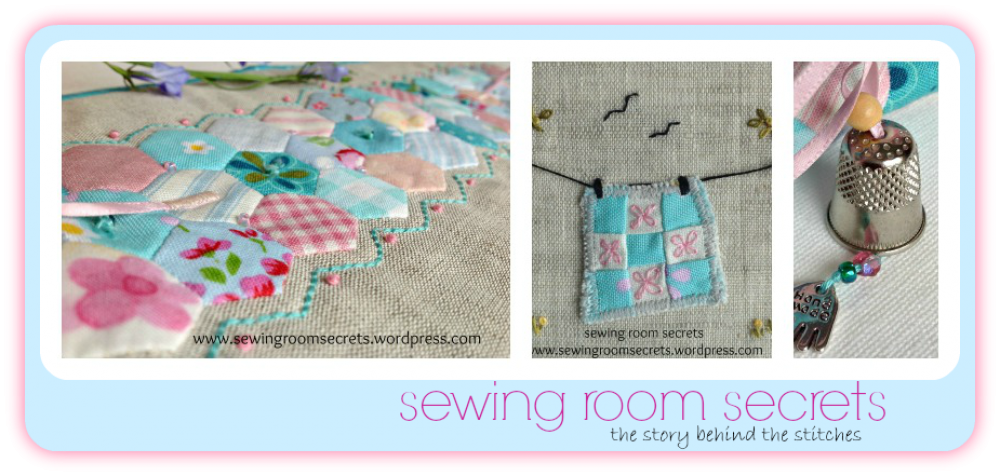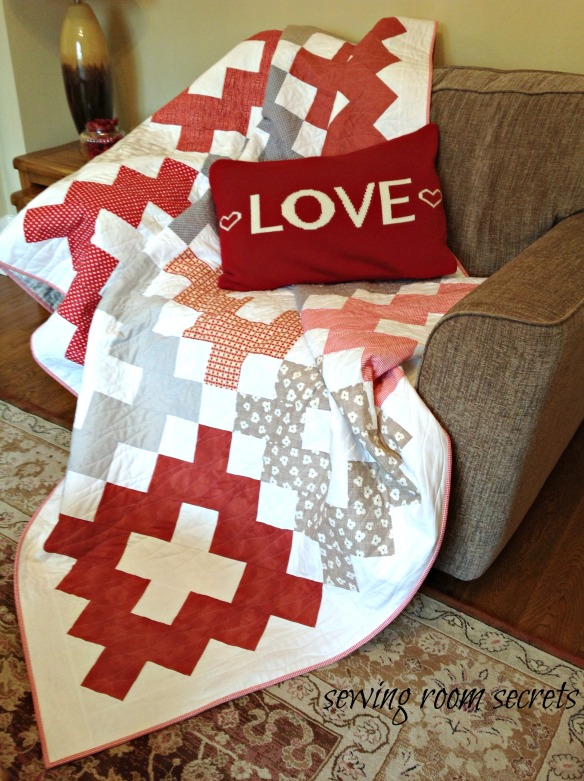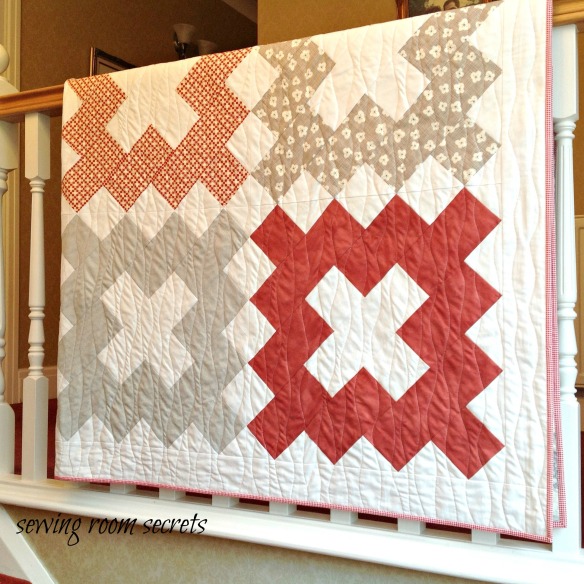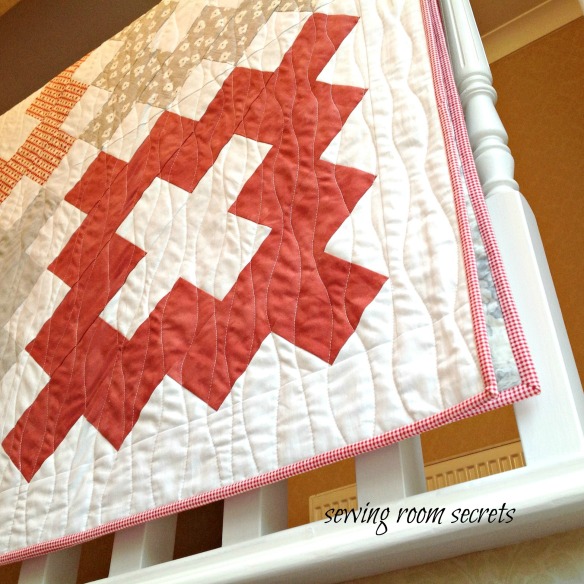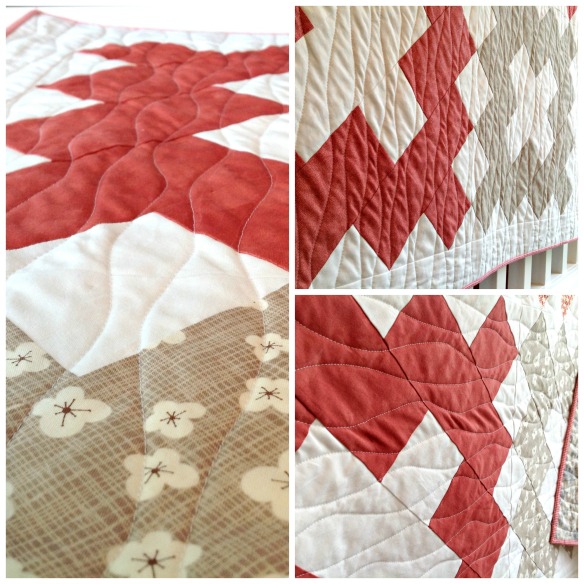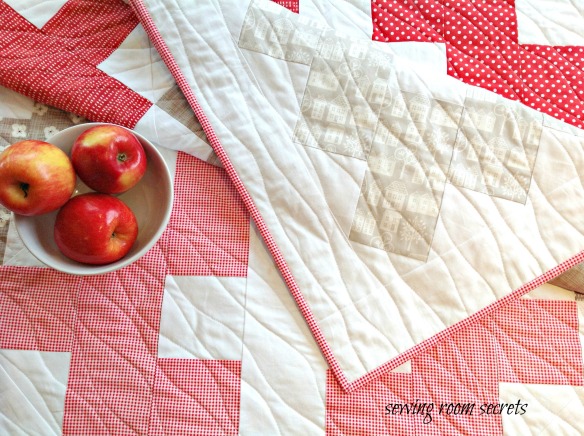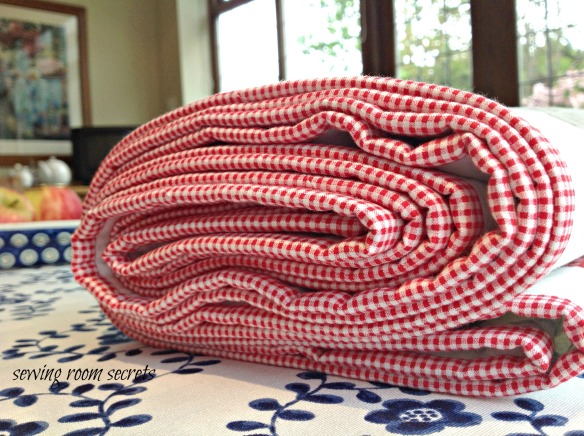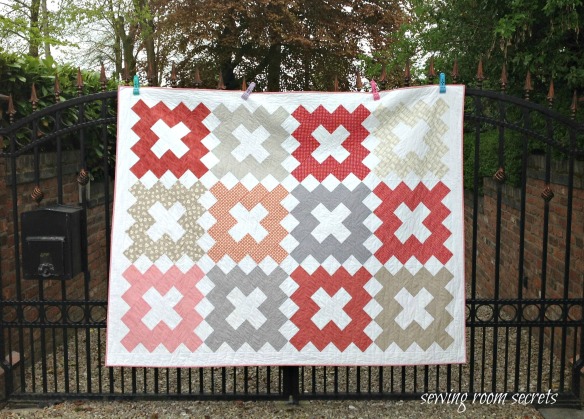There are lots of ways to bind a quilt, but there is usually one way that we each turn to as our ‘go to’ method. One way that works well for me is the technique that I am about to show you – I hope it is helpful for those of you who are just starting out on your quilting journey and are perhaps a little unsure of how best to frame your masterpieces 🙂
I’m using my little Zakka style butterfly table topper quilt to demonstrate, but the method works for any size of quilt, large or small 🙂
The first thing I do is trim the edges of the quilt
 Then I calculate the amount of binding that I will need by measuring the perimeter of the quilt. In this instance, I am binding a small table topper quilt measuring 12.5″ x 21″, so the perimeter is the sum of all of the sides i.e. (12.5″ x 2) + (21″ x 2) = 67″. Then I add about 10″, to allow for turning the corners and overlapping a little at the start and finish (I like to call these extra inches ‘wiggle room’ – love that expression!). For this quilt I will need 77″ of binding.
Then I calculate the amount of binding that I will need by measuring the perimeter of the quilt. In this instance, I am binding a small table topper quilt measuring 12.5″ x 21″, so the perimeter is the sum of all of the sides i.e. (12.5″ x 2) + (21″ x 2) = 67″. Then I add about 10″, to allow for turning the corners and overlapping a little at the start and finish (I like to call these extra inches ‘wiggle room’ – love that expression!). For this quilt I will need 77″ of binding.
Next I cut enough strips of fabric, which when joined together will give me one long strip of binding equal to the length I need. Now, this is where I differ a little from the norm in that I cut my binding strips 2¼” wide as opposed to the more widely used 2½” width. The reason I use 2¼” wide strips is because I like a ‘scant’ binding that sits snuggly against the sides of the quilt and I find that this width gives me the best finish.
For a large quilt I would cut the strips across the width of the fabric (from selvedge edge to selvedge edge), but for small projects, like this one, I sometimes cut strips from a fat quarter – it doesn’t really matter how you get there, so long as you make enough binding to go around the perimeter of the quilt, plus 10″ extra and without too many joins along the way!
Sew the strips together by placing two strips at right angles to each other, with right sides facing. Draw a line diagonally from left to right like this …
Then stitch on the drawn line and trim away the excess fabric leaving a ¼” seam at the join
Press the seams open so that the binding will lie flat when you apply it to the quilt
 Once you have joined all the strips together in this way, press the entire thing in half lengthways, wrong sides together.
Once you have joined all the strips together in this way, press the entire thing in half lengthways, wrong sides together.
You are now ready to apply the binding to your quilt! Before you start any stitching, open the binding strip and bring the top right hand corner down to meet the bottom edge of the strip like this
Fold the strip back together again. This forms a little ‘flap’ into which you will tuck the end of the binding later …
I usually start applying the binding at around the midpoint on the bottom edge of my quilt. Place the raw edge of the binding against the raw edge of the quilt top and pin.
Next, I mark ¼” from the corner edge like this
To stitch the binding on, I use a walking foot and a 1/4″ seam. I start sewing about 3 or 4 inches from the folded end and continue to sew towards the first corner. Now comes the important bit – stop stitching ¼” from the corner edge (your marker will guide you). Backstitch a few stitches and fasten off (but don’t cut your binding strip!)
Now I fold the binding strip straight up forming a 45˚ angle, then I fold it down over itself to create a corner and align the raw edge of the binding with the next edge of the quilt.
Start stitching at the top (backstitching a few stitches at the start), through the folded corner and all the way down the next side, stopping as before ¼” from the next corner like before. Continue to attach the binding in this way until all four corners are completed and you are a few inches from your original starting point.
Trim the end of the binding and tuck it inside the folded end that you started with like this, so that it overlaps by a couple of inches
Fold the flap back down again and continue to sew over the original starting stitches, backstitching to secure and fasten off.
Now turn the quilt over so that you can stitch the binding down to the back of the quilt.
It doesn’t really matter where you start, just fold the binding strip over from the front of the quilt to the back until it’s PAST the 1/4″ seam line that you made sewing the binding onto the front.
I use a ‘blind’ stitch to hold the binding in place at the back of the quilt. I hide the knot on the underside of the binding and bring my needle up through the fold in the binding
Next I insert the needle through the quilt backing and tunnel into the wadding for about 1/2cm just under the folded edge of the binding. Then I bring the needle back out and into the binding, as shown below
The secret to ‘blind’ (hidden) stitches is to catch only 2-3 threads with each “bite” of the binding and to take the stitch slightly under the edge of the binding fold. Aim for evenly-spaced stitches (½cm – 1cm apart works well). Be careful not to sew through to the front of your quilt!
Tip** You may choose to use clips or pins to help you hold your binding in place as you sew – it is not necessary to place a large number of them at a time, just enough for the next section ahead. Personally, I usually just hold it in place with my left hand as I go (I’m right-handed).
Continue to blind stitch the binding in place until you come to a corner. At the corner, fold the adjacent binding strip over to form a miter. Now bring your needle up through the backing to where the two binding strips intersect and make a stitch right in the corner by pulling the needle through both layers of binding. Make a few more stitches along the diagonal fold to secure the mitered corner.
Starting from the corner, blind stitch the binding to the next side of the quilt
This is how the corner looks on the front
Continue in this way until you have stitched all your binding neatly in place.
That’s it – you’re done! Time to start another project 🙂
Natalie x
